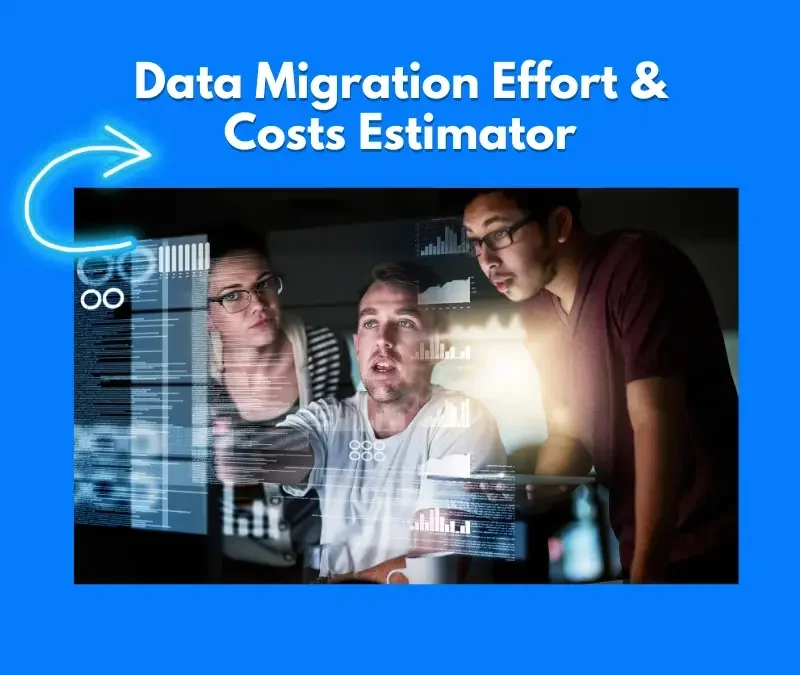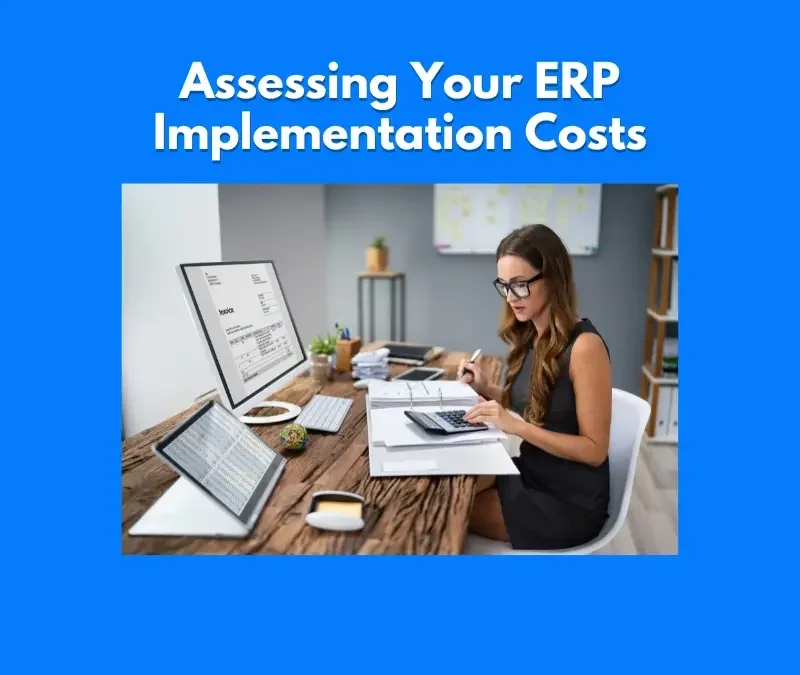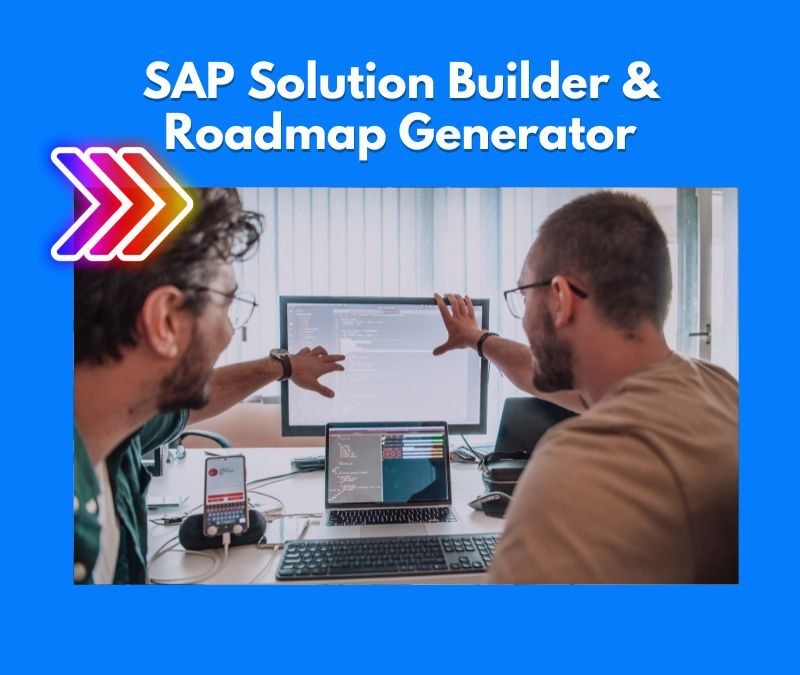SAP Articles
SAP CPI Consulting & Architecture: Real Integration Value
Noel DCosta
- Last Update :
What Does SAP CPI Really Do?
SAP CPI has become more relevant than ever, but the real challenge is knowing how and where to use it. On paper, it sounds straightforward. In practice, though, it can feel like a moving target.
This article is for those who manage integration every day. Architects, IT leads, project managers, the people that actually try to make systems talk to each other without breaking everything else around them.
You probably already know how frustrating it can be when a workflow works perfectly in theory but fails quietly in production.
What You’ll Take Away
A clear view of SAP CPI’s architecture
Where it helps most in real business use
I have worked with teams where SAP CPI brought order fast. But in other cases, things got worse before they got better. Some of that came down to design. Some of it was timing. And honestly, part of it was just rushing without a clear approach.
SAP CPI is powerful, no doubt. It can transform how integrations are built and managed. But it needs to be understood at the architectural level, otherwise, even small decisions can lead to technical debt later.
Let’s break it down properly. Step by step.
SAP CPI (Cloud Platform Integration) is a cloud-based integration service from SAP that connects different systems, both SAP and non-SAP, across cloud and on-premise environments.It handles data transformation, routing, and secure communication between applications to streamline business processes.
What is SAP CPI? (and What It's Not)

SAP CPI is SAP’s cloud-based middleware. It sits inside the SAP Business Technology Platform, quietly handling a task most businesses underestimate, which is making their systems work together.
You can think of it as the layer that connects cloud and on-premise applications. That part is easy enough to explain. What takes more time to see is how much friction this one layer can actually remove from daily operations.
I have seen teams spend months building brittle scripts between SAP and non-SAP systems. SAP CPI replaces that with structured integration flows, or iFlows. It offers message transformation, routing, application orchestration, and secure connectivity. All from one place. Once it is designed properly, it scales well too.
Where SAP CPI fits in the SAP ecosystem
Part of SAP BTP
Built to integrate with SAP S/4HANA, SuccessFactors, Ariba, and more
Works just as well with third-party platforms
Some confuse SAP CPI with tools like PI or PO. They share similar goals, yes, but the way they handle those goals is different. CPI is built for the cloud. PI was not. And while PI demands more infrastructure, CPI runs with much less overhead costs.
A quick note on what it’s not
SAP CPI is not an ETL tool. It is also not a full data warehouse or ERP solution. It does not store data long term. Instead, it moves data across systems and processes it along the way.
Sometimes that subtle distinction is missed. But for anyone evaluating integration tools, getting this right matters. Misuse leads to frustration later. Better to treat SAP CPI as what it was designed to be, a focused, cloud-first integration layer that ties business systems together without trying to do everything else.
What SAP CPI Actually Solves in Business Environments
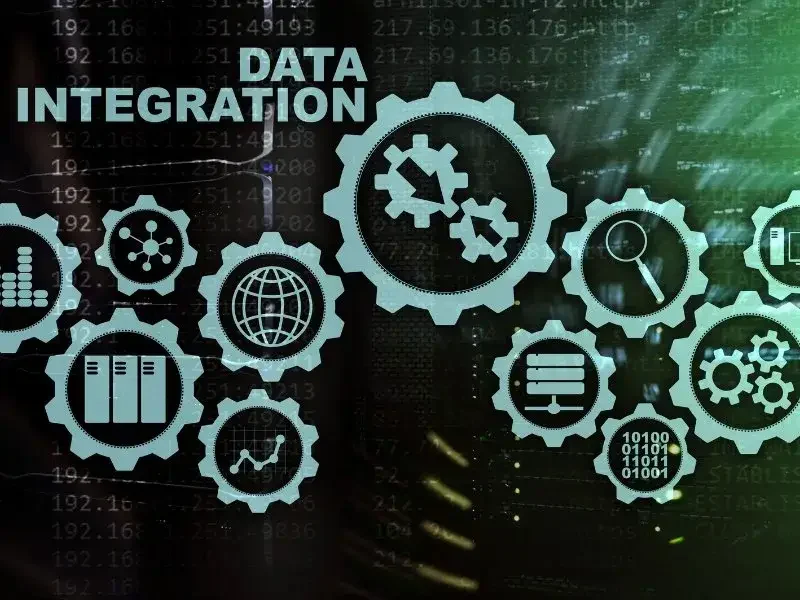
It often starts small. A sync delay here. A missing value there. Maybe a report pulls in old data, or an order sits unprocessed because two systems are just out of step. The more systems you add, the more those gaps widen.
SAP CPI steps in at that point, not as a quick fix, but as the foundation for reliable integration. It helps stitch together applications across landscapes, whether they are cloud-based, on-premise, or somewhere in between.
Take the order-to-cash cycle. A sales deal closes in Salesforce. That order needs to move into SAP for fulfillment, invoicing, and inventory updates. Without structured integration, people end up relying on exported spreadsheets or custom scripts. These often work at first, but over time, they break quietly or fail without warning.
SAP CPI helps replace that with a stable, reusable flow. It moves the data, transforms it as needed, and keeps the process consistent across systems and teams.
What does that really solve?
Reduces manual handoffs and re-entry
Removes fragile point-to-point logic
Enables clean automation between apps
Works across hybrid environments (cloud + on-prem)
Maintains consistency in how processes run
Integrates SAP and third-party solutions, like Salesforce, Workday, ServiceNow, and more
That last one is worth emphasizing. SAP CPI connects more than just SAP products. With the right adapters or through Open Connectors, you can hook into widely used SaaS platforms without custom middleware. In practice, that means fewer delays, fewer surprises, and more time spent solving real business problems instead of debugging interfaces.
Common Scenarios Where SAP CPI Adds Value
I have seen it improve integration outcomes in many environments. A few that stand out:
SAP SuccessFactors with S/4HANA
Syncing organizational data, compensation plans, or time trackingSRM to Ariba onboarding
Linking internal procurement workflows with vendor formsLegacy finance system to cloud analytics
Pushing structured data into SAP Analytics CloudSalesforce to SAP integration
Automating lead-to-cash or service-to-invoice pipelines
Sometimes it feels like integration should be easier. In truth, it often gets messy before it improves. But with SAP CPI, that improvement is not just possible, it is repeatable. And that matters most when you need the system to hold up over time.
SAP Cloud Platform Integration (SAP CPI) Features
| Feature | Description | Business Benefit |
|---|---|---|
| Prebuilt Integration Content | Library of pre-configured integration flows, adapters, and APIs for SAP and non-SAP applications. | Accelerates project delivery and reduces development time. |
| Cloud-Native Architecture | Built to run in multi-cloud environments with auto-scaling and elastic compute capabilities. | Ensures flexibility, scalability, and high availability of integrations. |
| API Management | Full lifecycle management for APIs including design, deployment, monitoring, and security enforcement. | Simplifies external integrations and strengthens security controls. |
| Graphical Integration Designer | Intuitive web-based interface for building integration flows using drag-and-drop tools. | Reduces technical complexity and accelerates design for both IT and business users. |
| Security and Compliance | Encryption, OAuth2.0, SAML, and secure transport protocols for all integration flows. | Protects sensitive business data and meets regulatory standards. |
| Monitoring and Logging | Real-time dashboards, alerting, and audit trails for integration transactions and performance. | Enhances operational visibility and speeds up troubleshooting. |
| Connectivity Support | Standard adapters for SOAP, REST, IDoc, JDBC, SFTP, OData, JMS, and more. | Simplifies integration with cloud, on-premise, and legacy systems. |
SAP CPI Architecture Explained: How It Works in Practice
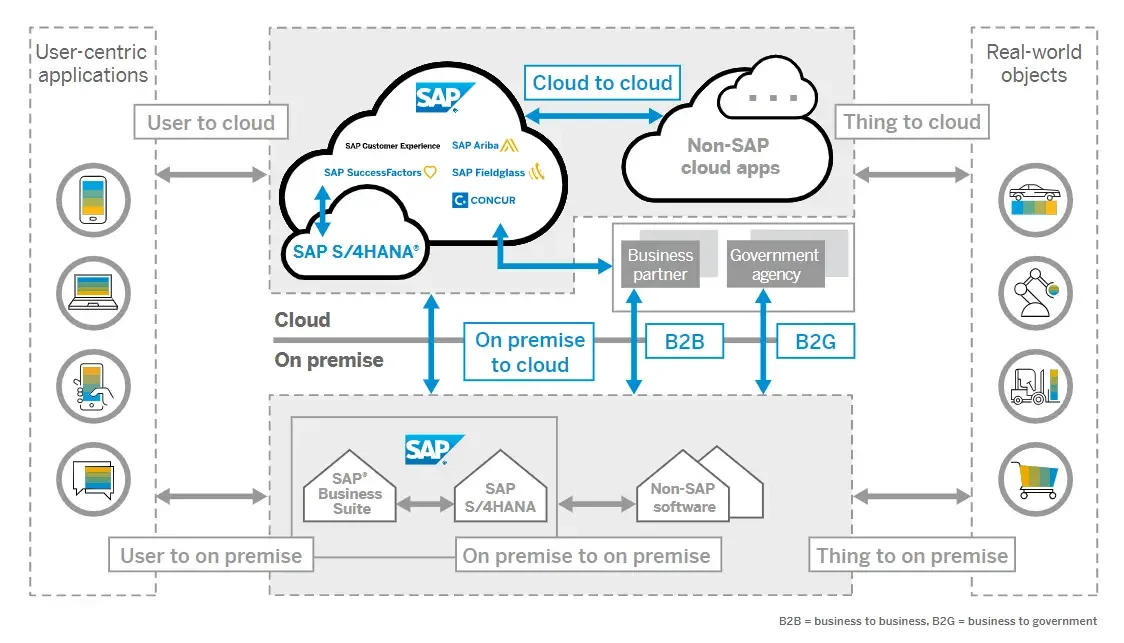
Understanding SAP CPI architecture is not just for developers. In my experience, the teams that grasp how CPI handles integration at a structural level tend to make better design choices up front. The architecture has a lot to offer, but it only works as well as it’s understood.
SAP CPI is cloud-native and built for multi-tenant environments. That matters more than people often think. It runs on SAP BTP and is meant to scale, without asking every customer to maintain their own infrastructure. So what you get is flexibility with less operational overhead.
At the core of it all is the iFlow. Every integration in CPI is modeled using these flows, and while they may look simple on the surface, they can handle complex logic when needed. Each iFlow moves data from a source to a destination through a series of structured steps.
The message flow in practice
Inbound adapter receives the message
Processing steps: mapping, transformation, conditional logic
Outbound adapter sends the processed data to its target
SAP CPI supports several protocols i.e. REST, SOAP, IDoc, SFTP among others. That makes it suitable for a wide mix of business scenarios. Hybrid ones especially.
Monitoring also plays a big role. You have logs, traces, persisted messages. Each serves a different purpose. During testing or debugging, I tend to switch between trace and persist depending on how deep I need to go.
Security is not bolted on, it is part of the architecture. CPI supports OAuth 2.0, HTTPS, and tenant isolation by default. You still have to configure it properly, of course, but the foundation is solid.
Components of SAP CPI Architecture
iFlow structure
Includes sender and receiver channels, steps, branches, and mappings.Adapter framework
You get prebuilt adapters for common systems. For anything else, there is custom adapter support.Runtime behavior
Flows can run synchronously or asynchronously, depending on the use case. It is not always obvious which to choose, so it helps to test.Groovy scripts
Used in areas where logic cannot be handled visually. I often suggest keeping this light. Too much scripting can lead to maintenance issues later.Deployment and versioning
Packages are version-controlled. Each change is deployed cleanly. No edits in production flows without packaging them first.
SAP CPI architecture is not overly complex. But like any framework, it rewards those who take the time to understand its patterns. That effort usually pays off quickly.
SAP Cloud Platform Integration (SAP CPI) Architecture Components
| Component | Description | Role in Architecture |
|---|---|---|
| Integration Flow Runtime | Executes integration flows (iFlows) for message processing and orchestration. | Core execution engine that handles routing, mapping, transformation, and security. |
| Design and Modeling Tools | Web-based integration designer and graphical editor to create, configure, and deploy iFlows. | Enables low-code/no-code integration development for IT and business users. |
| Connectivity Layer | Supports secure connections via adapters like SFTP, HTTP, IDoc, SOAP, REST, OData, JMS. | Handles communication between cloud and on-premise systems securely. |
| Security Layer | Manages authentication (OAuth 2.0, SAML), encryption, secure message transport, and audit logging. | Ensures data protection, compliance, and secure identity management. |
| Monitoring and Operations | Provides dashboards, message tracking, alerting, and runtime statistics for integrations. | Helps administrators monitor health, performance, and resolve issues proactively. |
| Prepackaged Content Library | Access to SAP-delivered integration packages, APIs, and best practice templates via API Business Hub. | Speeds up integration projects by using standardized, pre-tested content. |
| Cloud Connector | Secure tunnel that connects on-premise SAP/Non-SAP systems to SAP BTP services. | Enables hybrid cloud scenarios without exposing backend systems directly to the internet. |
Deployment: Neo vs Cloud Foundry in Practice
Choosing where to deploy SAP CPI is not always the first decision teams focus on. But it should be. The environment you pick will affect how your integrations evolve over time and how much flexibility you actually have down the road.
SAP offers two main options under its BTP landscape: Neo and Cloud Foundry. Each serves a purpose, but they are not equal when it comes to future readiness.
Neo is SAP-managed, a bit more rigid, and often used in earlier projects. It offers tighter integration with classic SAP services. That can be helpful in some regulated environments. But Neo has limitations. For one, extensibility is narrow. Also, runtime flexibility is minimal. You get what the platform provides, with fewer options to go outside the standard tools.
Cloud Foundry, on the other hand, gives you a more open environment. It supports multiple programming languages. Runtime is decoupled. You can deploy microservices alongside SAP CPI components and manage them independently. That freedom becomes important as your architecture grows.
Choosing the right path
Neo works for SAP-heavy landscapes with limited change
Cloud Foundry supports modern, hybrid, and evolving stacks
Most new SAP CPI implementations today go to Cloud Foundry
Unless you are tied to Neo by existing contracts or regional restrictions, I usually suggest Cloud Foundry. It simply offers more room to scale, adapt, and extend.
For a closer look at how BTP fits into your architecture, you might also explore Master the SAP BTP Cockpit. It helps clarify where SAP CPI sits in the bigger picture.
Planning a Migration from SAP PI/PO to CPI
Migration often starts as a technical requirement. But more often than not, it becomes a strategic one. SAP PI/PO was built for a different era i.e. on-premise systems, heavy infrastructure, and tighter control loops. It served its time well, but SAP CPI is where the investment is now.
SAP has been clear about the direction: Cloud-first. That means the longer you delay migration, the more compatibility gaps you may need to bridge later. With CPI, updates happen faster, integration content is more modular, and the platform aligns better with modern business systems.
The licensing model also changes. SAP CPI typically uses a consumption-based structure, tied to throughput or number of messages. That can feel like a shift, especially if your PI/PO cost model was more static. Some clients save. Others discover they have more traffic than expected and need to optimize flows earlier.
What the migration involves
The move is not automatic. Most PI interfaces need careful review. You cannot simply copy the logic over. There are differences in processing, error handling, and adapter behavior. What worked in PI might behave differently in CPI.
Some tools can help:
SAP migration toolkits
Prebuilt iFlow packages from SAP’s API Hub
BPMN visual flow comparisons for logic review
But those tools do not replace the deeper judgment calls.
That is usually where consulting adds value. I often work with clients to help prioritize:
What to rebuild entirely
What can be reused with small tweaks
Where flows need refactoring for performance
How to break down the rollout in waves, with fallback paths
Migration Checklist
Inventory all SAP PI interfaces: include frequency, volume, and business criticality
Categorize each interface: keep, rebuild, or retire
Estimate effort and risk: consider adapter type and scripting complexity
Plan regression testing early: especially across B2B partners or non-SAP targets
If your system still relies heavily on PI/PO, now is a good time to evaluate timelines. Migration takes effort, yes, but waiting longer usually costs more. You can also explore the SAP Integration Platforms overview to align your decision with the broader architecture.
More on SAP CPI, Integration & Landscape Planning
SAP Integration Platforms
Compare CPI with other middleware options used in real-world projects.
SAP Clean Core Strategy
How CPI supports a clean core approach by externalizing integrations.
SAP Quality Gates for Integration
Avoid broken CPI deployments with structured gate checks.
Planning SAP CPI in Project Controls
Track integration dependencies from blueprint to deployment.
Building Efficient Integrations with SAP CPI
Designing integrations with SAP CPI is not just about getting data from point A to B. That part, technically, is the easy bit. The hard part is keeping it clean over time. I have seen too many iFlows that started simple and turned into something no one wanted to touch six months later.
SAP CPI works best when flows are designed with business processes in mind, not just system endpoints. That shift makes a real difference. If your business is running a procure-to-pay cycle, for example, the integration flow should reflect the actual decision points, not just the system hops.
To build scalable integrations, start with structure. Separate what connects systems (adapters) from what processes logic (mappings, conditions). When those two blur, maintenance becomes harder than it should be.
Some practical habits I always recommend:
Use naming conventions that reflect business process and system context
Version iFlows cleanly and avoid editing live packages
Use parameterization for URLs, credentials, and dynamic values
Minimize direct use of Groovy. When needed, isolate scripts to mapping or routing blocks
Avoid chaining too many conditional steps in a single flow. Break it down if needed
You will also want to design with reuse in mind. That could mean creating utility subflows, shared mappings, or common error handlers. It saves time and keeps your architecture less tangled.
What “Good” Looks Like in CPI Projects
When someone else opens your integration six months later, they should not have to guess what it does.
Here is what I look for in well-built CPI implementations:
Flows are maintainable
Each part is logically grouped, clearly named, and easy to followError handling is built in
Includes routing for failures, logging, alerts, and fallback pathsCustom logic is minimal
Groovy used only when necessary, not everywhereDocumentation is part of the design
Notes, comments, and diagrams support handover or troubleshooting
If you plan this way from the start, your SAP CPI landscape becomes much easier to scale. It does not remove the complexity, but it makes it manageable. And that is usually enough to stay ahead.

See How I Make Your ERP and AI System Selection or Implementation right for you.
ERP & AI System Selection – Identify and choose the right ERP or AI-enabled platform to fit your business needs.
Project Support & Recovery – Keep your project on track or bring failing implementations back under control.
ERP Modernization – Transform existing ERP systems to modern, efficient, and scalable ERP environments.
GET IN TOUCHCommon Integration Points with SAP CPI
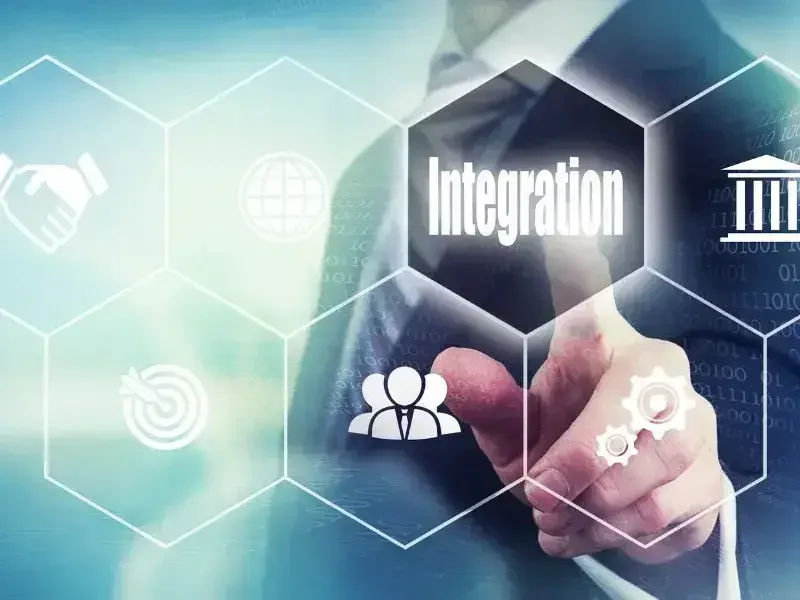
1. Connecting SAP Applications
When you first start working with SAP CPI, you might think it’s mainly about connecting SAP products. And sure, that’s a big part of it. Some of the usual suspects include:
SAP S/4HANA: whether it’s in the cloud or still running on-premise, it’s often the heart of the system landscape.
SAP Ariba: handling procurement, supplier management, and invoicing.
SAP Fieldglass: dealing with contingent workforce management.
SAP Concur: expense reports, travel bookings, tying into finance and payroll.
SAP-to-SAP integrations usually feel a bit more predictable. You can still run into surprises, but at least you’re operating mostly within the same ecosystem.
Common Integration Points Between SAP CPI and SAP Applications
| SAP Application | Integration Scope | Use Case |
|---|---|---|
| SAP S/4HANA | Business partner synchronization, order-to-cash, procure-to-pay, master data replication. | Real-time transaction processing across cloud and on-premise landscapes. |
| SAP SuccessFactors | Employee master data replication, payroll integration, time management. | Enable HR and workforce data synchronization with SAP ERP or third-party systems. |
| SAP Ariba | Purchase order integration, supplier invoice automation, sourcing event handling. | Procurement automation and supplier collaboration in hybrid environments. |
| SAP Concur | Expense report synchronization, travel booking integration, approvals workflow. | Seamless expense and travel data flow to ERP for finance reconciliation. |
| SAP Fieldglass | Contingent workforce data exchange, services procurement integration. | Improves contract labor management and project-based sourcing. |
| SAP Customer Experience (CX) | Lead-to-order integration, customer master data, pricing synchronization. | Enhances customer experience by linking front-office and back-office systems. |
| SAP Integrated Business Planning (IBP) | Demand and supply planning integration, inventory management synchronization. | Enables unified, real-time planning across supply chain systems. |
2. Connecting Non-SAP Applications
Real-world landscapes are messier. Most companies today run a mix of SAP and non-SAP systems, so CPI often has to bridge those gaps too:
Salesforce: especially for CRM data and lead management.
Microsoft Dynamics: sometimes running alongside SAP systems for finance or sales (even if it’s not always clear why).
Workday: used by some companies for HR instead of SuccessFactors.
Amazon Web Services (AWS): either as a storage backend or for advanced cloud services.
These integrations can be straightforward, or they can get weird fast, depending on how much customization has been done on both sides.
Common Integration Points Between SAP CPI and Non-SAP Applications
| Non-SAP Application | Integration Scope | Use Case |
|---|---|---|
| Salesforce | Customer data synchronization, lead management, order-to-cash flows. | Unifies CRM and ERP for streamlined sales operations. |
| Workday | Employee master data synchronization, talent management integration. | Consolidates HR processes across cloud and ERP landscapes. |
| Microsoft Dynamics 365 | Financial transactions, customer orders, and procurement integration. | Bridges SAP and Microsoft ecosystems for finance and operations. |
| ServiceNow | IT service ticket integration, incident management, asset tracking. | Enhances ITSM workflows connected to ERP environments. |
| Oracle E-Business Suite (EBS) | Financial postings, procurement data sharing, master data integration. | Manages hybrid SAP-Oracle deployments efficiently. |
| Zendesk | Customer ticketing system integration, service workflows. | Improves customer service operations through connected systems. |
| AWS (Amazon Web Services) | Storage services (S3), event-driven integration via AWS Lambda, API Gateway connections. | Enables scalable, cloud-native integrations between SAP and AWS services. |
| Google Cloud (GCP) | BigQuery integration, data lakes, machine learning APIs. | Supports analytics, data warehousing, and AI-driven innovation. |
3. Connecting Third Party APIs
There’s also a ton of work around third-party APIs. CPI handles both REST and SOAP interfaces, but let’s be honest, REST is usually cleaner.
SOAP still shows up a lot more than you’d expect, especially in older B2B systems.
Common Integration Points Between SAP CPI and Third-Party APIs
| Third-Party API | Integration Scope | Use Case |
|---|---|---|
| Stripe API | Payment processing, invoicing, customer billing synchronization. | Integrate real-time payment flows into SAP ERP systems. |
| Twilio API | SMS alerts, call notifications, two-factor authentication (2FA). | Enable messaging services for SAP-driven workflows. |
| DocuSign API | Digital contract signing, approval workflows for procurement and HR. | Accelerates procurement and employee onboarding processes. |
| Google Maps API | Location tracking, address validation, supply chain optimization. | Enhances logistics, shipping, and customer service operations. |
| Slack API | Real-time alerts, workflow notifications, team collaboration messaging. | Boosts collaboration for integration-driven business processes. |
| LinkedIn API | Candidate profile retrieval, job posting synchronization with HR platforms. | Enables smart recruiting workflows integrated with SAP SuccessFactors. |
| SAP Business Network APIs (Ariba, Fieldglass, Concur) | Procurement, expenses, supplier management, and services procurement. | Seamless third-party integration with SAP cloud solutions. |
| AWS Lambda and API Gateway | Serverless function execution for custom workflows and event-driven processing. | Real-time event triggers between SAP CPI and cloud services. |
4. Connecting On-Premise Systems
Cloud isn’t everything. You still have plenty of on-premise systems sticking around:
SAP ECC: often during long, slow migrations to S/4HANA.
Legacy databases: Oracle, SQL Server, or whatever else the company’s been running for decades.
CPI has ways to tunnel into these old systems, but it’s rarely as quick as you hope.
Common Integration Points Between SAP CPI and On-Premise SAP Systems
| On-Premise SAP System | Integration Scope | Use Case |
|---|---|---|
| SAP ECC | IDoc, RFC, BAPI, OData, SOAP communication through SAP Cloud Connector. | Order-to-cash, procure-to-pay, finance integration with cloud systems. |
| SAP S/4HANA (On-Premise) | Core Data Services (CDS), OData APIs, SOAP and REST API endpoints. | Real-time master and transactional data replication to external systems. |
| SAP PI/PO (Process Integration/Orchestration) | Message-based integration using SOAP, IDoc, RFC adapters. | Bridge between legacy middleware and modern cloud platforms. |
| SAP Business Warehouse (SAP BW) | Data extraction using OData, REST APIs, and SAP BW Open Hub services. | Cloud analytics, data lake population, business reporting integrations. |
| SAP CRM (On-Premise) | Business partner, service request, opportunity management integrations via SOAP and RFC. | Integrate CRM processes into unified customer engagement platforms. |
| SAP SRM (Supplier Relationship Management) | Supplier master, sourcing event, purchase order synchronization. | Aligns on-prem procurement systems with cloud procurement strategies. |
| SAP Solution Manager | Monitoring alerts, ticketing events integration with ITSM systems. | Enhances end-to-end IT service management visibility. |
5. EDI and B2B Integrations
If you’re working in industries like manufacturing, retail, or logistics, EDI (Electronic Data Interchange) and B2B scenarios are pretty much unavoidable. CPI supports these through B2B add-ons, though setting them up often feels more painful than it should be.
Common Integration Points Between SAP CPI and EDI/B2B Systems
| EDI/B2B System | Integration Scope | Use Case |
|---|---|---|
| EDI VAN Providers (e.g., OpenText, IBM Sterling) | Connects through AS2, SFTP, or API to exchange ANSI X12, EDIFACT documents. | Automated order processing, shipment notices, invoice exchanges with trading partners. |
| Direct EDI Connections | Direct partner integration via AS2, SFTP for POs, ASN, invoices (EDI 850, 810, 856, etc.). | Faster, lower-cost EDI integration without using a VAN network. |
| Ariba Network B2B Integration | Integration for purchase orders, goods receipt notices, invoices between SAP Ariba and ERP systems. | Streamlined procurement and supplier collaboration workflows. |
| B2B Adapters (in SAP CPI B2B Add-On) | Support for EDI-specific standards like X12, EDIFACT, Odette, VDA, RosettaNet protocols. | Standardized B2B message translation, validation, and partner communication. |
| e-Invoicing Compliance (e.g., Peppol, eWayBill) | Transmit e-invoices directly to government portals or e-business platforms. | Ensures legal invoicing compliance across geographies (Europe, India, LATAM). |
| 3PL & Logistics Providers (e.g., DHL, FedEx APIs) | Shipment tracking, goods movement confirmations, ASN transmission. | Automates logistics updates within supply chain systems connected to SAP ERP. |
| Payment Gateways (e.g., PayPal, Stripe EDI) | Settlement reports, payment acknowledgments, remittance advices. | Streamlines accounts receivable automation linked to SAP FI/AR modules. |
Integration Patterns Supported by SAP CPI

When you start working with SAP CPI, you quickly realize it’s not just about pushing data around. It’s about how you move it, transform it, and sometimes even recover when things go wrong. SAP CPI supports a few core integration patterns that you’ll run into over and over.
1. Content-Based Routing
One of the first patterns you’ll use is Content-Based Routing.
Basically, you look inside the message, maybe at a field or a header, and decide where it should go next.
For example, orders over a certain value might get routed to a different system for special handling.
It’s simple but powerful. And if you don’t design your conditions carefully, it can also cause a lot of confusion later when messages land in places they shouldn’t.
2. Message Transformation
You almost never get matching formats between systems.
Message Transformation is about reshaping incoming data into the format the target system expects.
Sometimes it’s just renaming fields, sometimes it’s full-on restructuring. You can use graphical tools, scripting, or external mapping files, whatever gets the job done.
3. Publish-Subscribe (Asynchronous Messaging)
Sometimes you don’t want a direct connection at all.
Publish-Subscribe lets one system publish a message and multiple subscribers pick it up independently. It’s good for decoupling systems, but you do lose tight control over sequencing.
4. Multicast and Parallel Processing
There are cases where you need to send the same message to multiple targets at once.
That’s where Multicast comes in. CPI can also process branches in parallel, which saves time but can also make troubleshooting harder if one path fails and the others don’t.
5. Exception Handling
Finally, you have Exception Handling, arguably one of the most important pieces.
No integration is perfect. You have to plan for failures: retries, alerts, dead-letter queues, or fallback processes. Otherwise, you’ll spend a lot of weekends cleaning up silent errors.
Integration Patterns Supported by SAP CPI
| Integration Pattern | Description | Typical Use Case |
|---|---|---|
| Message Routing | Route messages based on content, headers, or conditions. | Direct different business transactions (orders, invoices) to different systems. |
| Content-Based Message Processing | Transform, enrich, split, or aggregate messages based on business logic. | Modify order details before reaching downstream applications. |
| Asynchronous Messaging | Non-blocking message exchange using queues, JMS, or webhooks. | Submit a customer order without waiting for order confirmation immediately. |
| Synchronous Messaging | Real-time request-response processing using APIs or web services. | Product availability check from ERP triggered by e-commerce portals. |
| Publish/Subscribe | Decouple producers from consumers by using event-driven communication. | Broadcast new product launches to multiple marketplaces simultaneously. |
| Batch Data Processing | Handle scheduled bulk transfers of data between systems. | Nightly synchronization of master data between CRM and ERP. |
| Event-Driven Processing | Trigger integrations based on system events or external triggers. | Initiate a shipment process automatically after order fulfillment event. |
| File-to-File Integration | Transfer and transform files between two systems using SFTP or cloud storage. | Automated invoice file transfer from suppliers to ERP finance modules. |
What Kind of Support SAP CPI Actually Needs
SAP CPI runs well out of the box. At least, that is what many assume at the start. And yes, it provides built-in dashboards, message monitors, trace logs, and runtime data. But day-to-day support involves more than just watching for errors.
Once flows are active, the real work begins. You need to know what failed, why it failed, and whether anyone caught it before business was impacted. That requires alerts. And alerts require proper setup. CPI does not push everything by default. So log retention, retries, escalation thresholds, these all need extra attention.
I have seen projects where integrations looked stable but quietly dropped messages for weeks. It was not a design flaw. It was a support blind spot.
What SAP CPI gives you
Monitoring tools with message trace, payload view, and runtime health
Dashboard for system metrics and tenant usage
Basic logs for flow execution and message paths
What you need to configure
Custom alerting by severity or endpoint
Retry logic for unstable receivers
Retention policies that match compliance or audit needs
Support also means lifecycle thinking. What works today may break next month. APIs change. Data structures shift. New systems get added to the mix.
That is where consulting support brings real value. Not just during go-live, but afterward when flows evolve, and you need a second opinion before something breaks.
Supporting Evolving Landscapes
APIs change often
A small update in a third-party system can break an entire flowRegression testing matters
Especially when changes happen outside of CPI’s controlHaving a consulting partner helps
Someone to guide fixes, handle triage, or even spot issues before they escalate
SAP CPI is not difficult to support. But support takes planning. And that usually starts with knowing what to look for, long before the first alert shows up.
Monitoring, Administration, and Troubleshooting with SAP CPI

Once your iFlows are live, the real work honestly just begins. Monitoring and troubleshooting are not optional, they’re your safety net when (not if) things go sideways.
1. Monitoring Tools
SAP CPI gives you a few different tools to keep an eye on what’s happening:
Message Monitoring shows you a list of all the messages being processed, including the ones that failed. It’s usually the first place you check when something looks off.
Integration Flow Monitoring lets you see the status of deployed iFlows, whether they’re running, stopped, or throwing errors.
Node Health Monitoring tracks the background infrastructure, like runtime nodes. If something’s slowing down or crashing behind the scenes, you’ll catch it here.
It’s not one tool fits all. You’ll probably flip between them depending on what’s going wrong.
2. Logs
Logs are your second line of defense, and in CPI, you get a few key types:
Detailed Payload Logs capture the actual message content at different stages. Super useful when transformations don’t do what you expected.
Security Logs track authentication, authorizations, and any weird access attempts.
You don’t always need logs, but when you do, you really need them.
3. Typical Troubleshooting Approach
When stuff breaks, and it will, you usually follow a rough pattern:
Failed Message Analysis: Find the failed message, look at the error details.
Alerting and Notification Mechanisms: Set up alerts so you hear about failures immediately instead of days later. CPI doesn’t scream at you by default, you have to make it scream.
Honestly, good monitoring habits can save you from a lot of midnight phone calls later.
Monitoring with SAP CPI
| Monitoring Area | Purpose | Key Features |
|---|---|---|
| Message Monitoring | Track the status of messages processed through integration flows. | Message payload inspection, retries, error tracing, detailed runtime logs. |
| Integration Flow Monitoring | Monitor deployed iFlows, deployment status, and runtime health. | iFlow versioning, active vs failed deployments, artifact runtime statistics. |
| Adapter-Specific Monitoring | Check health and connectivity of configured adapters (SFTP, HTTPS, IDoc, etc.). | Endpoint availability, credential validations, adapter-specific error logs. |
| System Health Monitoring | Monitor tenant-level system metrics and general system health. | Resource utilization, processing queues, database health, node uptime. |
| Audit Logs | Review audit trails of administrative changes for compliance and governance. | User actions, deployments, credential changes, endpoint modifications. |
| Custom Alerting (via SAP Alert Notification Service) | Send proactive alerts for integration issues and system faults. | Real-time email, SMS, webhook alerts based on pre-configured thresholds. |
How I Help Clients with SAP CPI
Most of the SAP CPI work I do starts with one of three goals. Either something is breaking and needs to be stabilized, or a team wants to automate a process that is still partly manual, or they are buried in legacy integration logic and want a way out.
Whatever the case, the actual request usually sounds simple. But the complexity sits underneath. Hidden dependencies, custom logic, undocumented flows. That is where the right structure matters.
My role tends to cover both the high-level architecture and the details inside the iFlows. That means planning how systems should interact, yes, but also writing and testing the actual integrations.
What the work typically includes:
Reviewing existing SAP PI or middleware setups
Designing the new SAP CPI landscape to match business process goals
Building, testing, and optimizing iFlows
Guiding phased rollouts and post-go-live tuning
One recent example was a retail client with separate systems for e-commerce, logistics, and finance. We moved them from PO to CPI in stages, starting with customer orders, then moving to supplier updates and inventory. The flows were not overly complex, but the volume made it hard to test quickly. What helped was breaking them into smaller pieces, each one scoped to a clear outcome.
What I try to keep consistent is the way I work:
Always scoped
Always business-aligned
And always transparent
No surprises. No overengineering.
Where Clients Typically Need Help
Structuring flows so someone else can maintain them later
Working around limitations in APIs or data formats
Reducing cycle time from testing to production
SAP CPI has a learning curve. But with the right support, teams can move from just making it work to actually making it reliable. And that is usually where real value shows up.
SAP CPI Governance, Risks & Scope Control
AI Governance in SAP Projects
How CPI integration aligns with auditability and risk frameworks.
SAP Scope Template
Managing CPI project scope and integration boundaries.
Avoiding Integration Scope Creep
Strategies to keep CPI in check through delivery cycles.
ERP KPIs for Integration Success
Track CPI impact with the right KPIs across deployment phases.
Conclusion
SAP CPI can do more than just connect systems. When used well, it becomes part of how a business runs, not just a layer behind the scenes, but something that helps teams move faster, with fewer gaps between processes.
The real difference often comes down to architecture. A good one creates stability. It keeps integrations clear, consistent, and easier to scale. A rushed or scattered setup, though, tends to create friction that only grows over time.
In my view, SAP CPI success is less about tools and more about structure. How the flows are planned. How the logic is maintained. That is where consulting adds value. Not as overhead, but as a way to make sure time and effort are spent where they matter.
If you are exploring SAP integration or just want to look at your current setup with fresh eyes, I would be happy to discuss your use case. Sometimes that first conversation is the one that clears the path forward.
If you have any questions, or want to discuss a situation you have in your SAP Implementation, please don't hesitate to reach out!
Questions You Might Have...
1. What is a CPI in SAP?
CPI stands for Cloud Platform Integration in SAP. It’s a cloud service that helps different systems talk to each other i.e. SAP systems, non-SAP systems, cloud apps, on-premise software, all of it. You could think of it as the bridge that moves and transforms data between systems so processes run smoothly across different platforms. It’s not new in concept. Integration middleware has existed for a long time, but CPI does it in the cloud, without needing heavy infrastructure.
2. What is SAP CPI called now?
Today, SAP CPI is part of what’s called the SAP Integration Suite. Technically, “CPI” as a standalone term is still widely used informally by consultants and developers (out of habit, maybe), but officially, SAP folded it into Integration Suite as one of the services under that broader umbrella.
3. Is SAP CPI the same as BTP?
No, not exactly. BTP (Business Technology Platform) is the full platform, kind of like the house, and CPI (or Integration Suite, to be more formal) is just one room inside that house. BTP covers way more: app development, database management, AI services (even if that term feels a little hyped), analytics, and more. CPI specifically handles integration.
4. Is SAP CPI a good career?
It can be, but it’s not for everyone. If you like solving puzzles, handling messy data, figuring out why System A won’t talk to System B, CPI work is pretty rewarding. The demand for SAP integration specialists is stable because every big company that runs SAP needs integration, no exception. That said, the field can feel a little behind the glamour of app dev or AI stuff, if that matters to you.
5. Is SAP CPI difficult?
I wouldn’t call it easy, but it’s manageable. The hard parts are usually understanding business processes and knowing a hundred little technical things (like security certificates, APIs, mappings). If you’re comfortable with XML, APIs, and general software architecture concepts, you’ll pick it up faster. People get stuck when they try to learn CPI and SAP backend processes at the same time as it can quite complicated.
6. Is SAP CPI an ETL tool?
Kind of, but not exactly. CPI does Extract, Transform, and Load type activities as part of integration, but it’s not an ETL tool in the classic sense like Informatica or Talend. It’s really designed around real-time or near-real-time message processing rather than big batch data migrations.
7. Is SAP CPI a middleware?
Yes. CPI is SAP’s cloud-native middleware solution. It sits between different systems and manages message transfer, transformation, and orchestration. Middleware is a broad term though, and SAP has had a few over the years (PI, PO, now CPI).
8. What happened to SAP PI/PO?
SAP PI (Process Integration) and PO (Process Orchestration) are still around, but SAP is slowly nudging customers toward moving to cloud solutions like CPI. PI/PO were built for on-premise. SAP hasn’t killed them, but the message is clear: future innovations and serious support will happen in the cloud. Some companies will probably run PO for years even though migration is expensive and risky.
9. Does SAP CPI require coding?
A little bit, yes. You’ll need to understand scripting languages like Groovy or JavaScript for more complex mappings and data transformations. It’s not hardcore software development, but it’s also not “zero-code” either. If you can’t write a for-loop or manage basic error handling, you’ll struggle.
10. What is the use of a cloud connector in SAP?
Cloud Connector is a tool that links your on-premise systems securely to SAP’s cloud services like CPI or S/4HANA Cloud. Think of it as a secure tunnel. Without it, cloud services wouldn’t be able to safely reach into your private network. It controls what’s exposed and keeps IT security folks happy.
11. What is SAP CPI monitoring?
Monitoring in CPI is checking the health of your integrations: are messages getting through? Are there errors? Is latency too high? CPI provides tools where you can see message logs, error stacks, retries, and system health dashboards. Good monitoring practices save you from getting late-night calls about failed integrations.
12. Is SAP CPI a SAAS or PAAS?
It’s more Platform as a Service (PaaS), technically. CPI gives you tools to build, manage, and deploy integration flows. It’s not just a finished app you use. However, parts of Integration Suite sometimes feel closer to SaaS, depending on how you use it. It’s a bit blurry because cloud services often don’t fit into one neat category anymore.
13. What is the difference between SAP PO and CPI?
At a high level:
SAP PO is on-premise, heavyweight, full control, but harder to maintain.
SAP CPI is cloud-native, lighter, easier to update, and better integrated into SAP’s broader cloud ecosystem.
PO gives you more power to customize deeply, while CPI leans toward agility and faster deployments. Companies migrating usually trade deep control for faster time-to-market.
14. Is SAP CPI same as Integration Suite?
Not exactly. CPI is part of Integration Suite. Integration Suite includes CPI plus other services like API Management, Open Connectors, Trading Partner Management, and more. CPI is just the piece that handles traditional integration flows (the stuff similar to old-school middleware).



